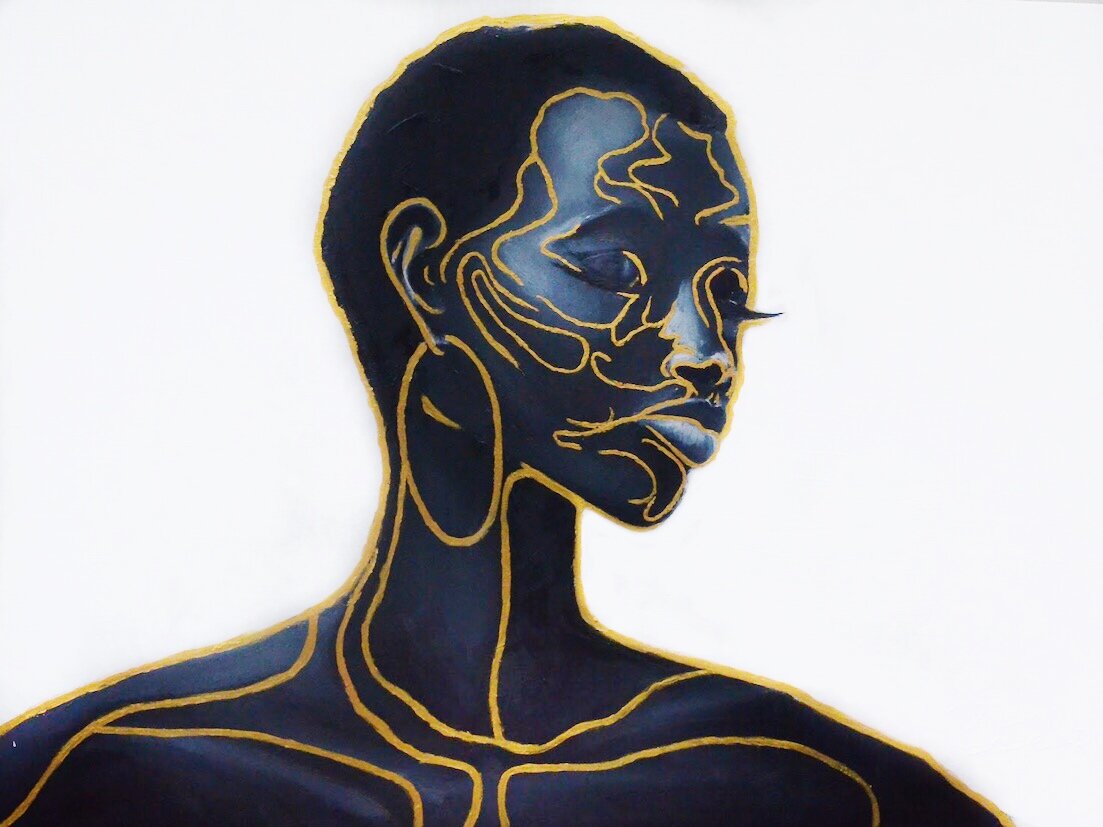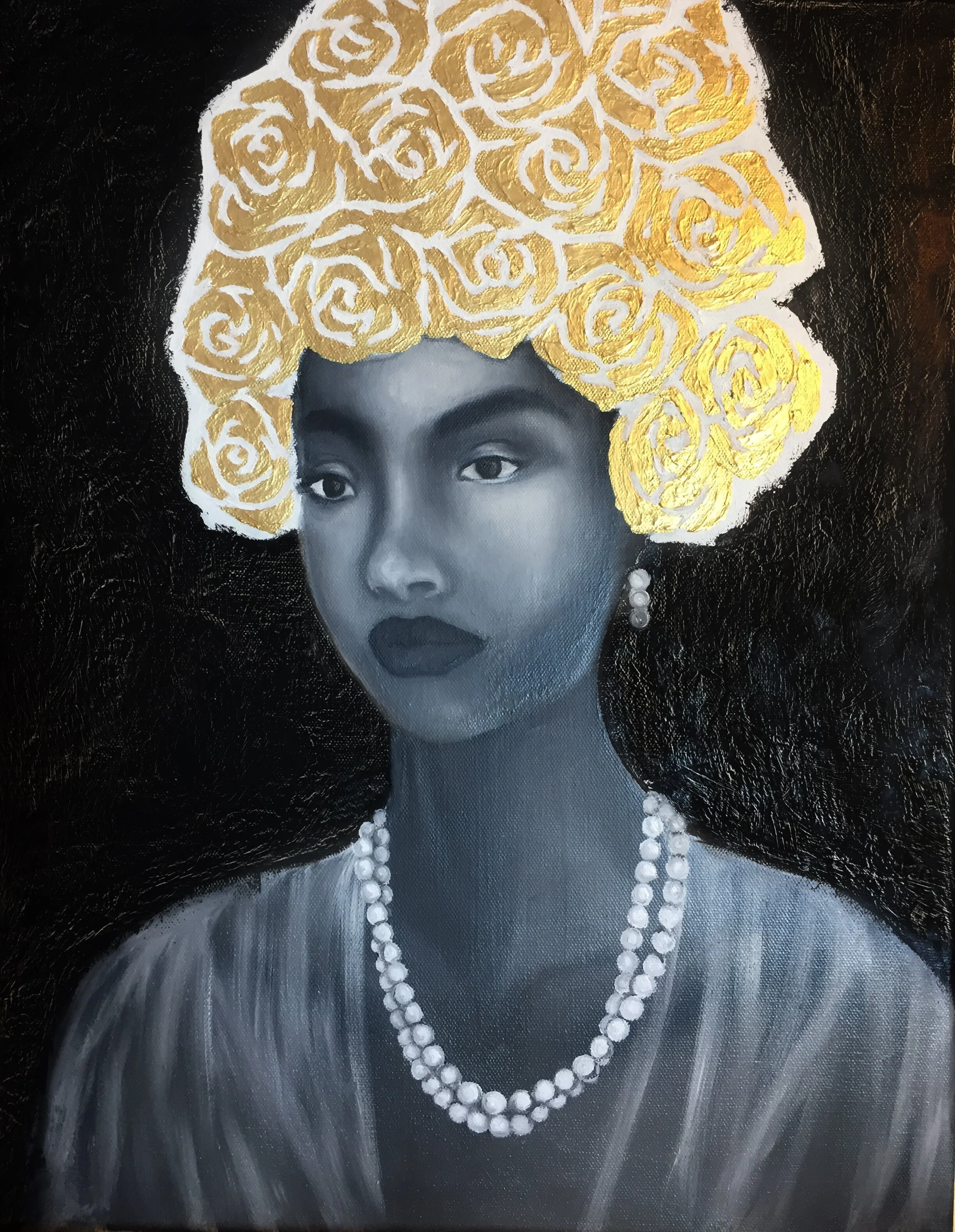The Visual Artist: Pasteur Mudende
Art institutions have the distinct power of humanizing the ‘Other’ by demonstrating that Art truly belongs to everyone and letting everyone see themselves represented.
5 QUESTIONS WITH Pasteur Mudende
visual Artist, curator, educator
Fargo, ND
Born in Kigali, Rwanda, Pasteur Mudende is a unique talent, one whose artistic gift lands outside the normal order. Some of his favorite childhood memories were the days spent admiring the beauty of African art in galleries. Which is why he is heavily influenced by stunning African silhouettes and French Impressionism as well. His emotional, plaintive minimal paintings often express feelings of loneliness and sometimes deal with racy subject matter and are in between a confidence and fragile state. Mudende’s full biography and images of work follow the interview.
1. Tell me how BE, EXIST at the Plains Art Museum came to be…
It all began in mid-June as local social justice movements activists were inspiring us to really look within and face these challenges head-on. There was a need for us to stand with, join, to show our support to the social debate. Michael Eback, a local artist, and DJ reached out to the museum with the idea of creating a mural that responded directly to the time and also supported the resurgence of the Black Lives Matter movement in Fargo, ND. During the discussions about the mural, with the team that consisted of Michael, Aluel Maciek, Netha Cloeter, Andy Maus, and me, we knew that this was a very crucial time and that we weren’t going to settle for a mural and be comfortable.
The Plains Art Museum, being a major cultural institution in our community, is aware that the ongoing humanitarian debate was an issue that needed to be addressed and was committed to searching solutions. Museums can be intimidating and sometimes feel unwelcoming to racial minorities even though within a greater context museums are cited as public institutions. So to counter this narrative we decided to also curate the exhibition which came to be known as BE/Exist. The exhibition serves as an open door to Black, Indigenous, and People of Color in our community to come to stroll confidently into this public institution and peruse through the myriad artworks the Museum has to offer.
2. GROUP THINK — an incubator of “honest conversation with a diverse group of thinkers” taking “time to explore often unasked questions and a chance to engage a plurality of perspectives (and not need to agree)” — was involved in the exhibition development. How did this process unfold?
When the museum decided to go ahead with the BE/Exist exhibition, we knew that if we were going to make meaningful change, we had to put in the time, gather minds, and figure out how to respectively approach the cultural discourse that surrounds institutions like art museums. Being one of many organizers of GROUP THINK, I knew first hand how powerful and enlightening a conversation can be when we actively engage a plurality of perspectives. It made sense to include a GROUP THINK conversational guide with the exhibition as a way to have the public approach the conversation on their own terms.
We held a virtual meeting with the GROUP THINK team, local activists, and artists. The conversation that we had in that meeting really helped us shift our gaze and re-contextualize the narrative. Initially, the working title of the exhibition was UBUNTU — an East and Southern Africa world philosophy of the kindness and connectedness felt within humanity. Basically, UBUNTU is the verb to the noun Human. The title was great, however, the times and challenges that BIPOC individuals in our community are facing weren’t being addressed directly. We wanted to liberate these voices that are somehow trapped in the predominant culture’s imagination. We were compelled to ask questions such as: Who values your life? Where do you feel safe, protected, unquestioned, at home?
One major takeaway from the GROUP THINK meeting is how we were left with the challenge of shrugging off the burden most BIPOC face, which is having to reintroduce or explain why are we occupying a particular public space. Which in turn influenced the direction the exhibition took and also the final title BE/EXIST.
3. Looking at the arts funding system — within the context of a global health crisis, a pandemic-induced recession, and a growing social justice movement — what do you think we most urgently need to change?
The global health pandemic and the social justice movement has inspired many industries to reimagine and revisit their current role in their communities. Many art based establishments, and nonprofit organizations have committed to focusing on their diversity and inclusion policies. However, it is one thing to say we change and to actually intentionally working towards that attaining that goal. Aside from financial capital, art museums usually have a very wealthy social capital that they can turn to and engage them in a conversation and evaluate the steps they need to make for change.
4. Arts Funders Forum (AFF) research has shown that the cultural sector has been experiencing a crisis of relevancy, and that many believe this is a result of underdeveloped narratives for the next generation of audiences and supporters. What narratives should we be telling to make the arts more valued in our society?
Art museums are supposed to be leading and taking on the role of embracing diversity and expanding the demographic. Art institutions have the distinct power of humanizing the ‘Other’ by demonstrating that Art truly belongs to everyone and letting everyone see themselves represented. Art institutions need to have a fair representation of different national origin, religion, race, and sexual orientation to be more attractive. I do believe that museums need to restructure and reinvent themselves in a manner that allows them to absorb culture rather than being the purveyors of culture.
Historically, underrepresented artists have been searching for ways and a space to exist where their subjectivity could be articulated in a manner that dignifies their sense of being. Even today, a simple google search can lead you to a plethora of artists that are telling their own narrative. Art institutes need to find a way to bridge that gap by including these voices to ensure relevancy.
5. From your perspective as a working artist, curator, and museum educator, what can individuals do right now to best support artists and the cultural ecosystem?
The connection between the arts and the growth of a community is inextricable. Artists, museums, galleries, and other art institutions have struggled to remain active due to the current global health crisis. Access to funding and grants is crucial however, I am a believer in grassroots inspired growth. There are numerous ways we can individually step help make a significant difference.
1. Financial Support: Art comes in all shapes and forms. Sculpture, prints, music, drama, photography, and painting. Every piece of art, large or small, takes a tremendous amount of time, love, and thought. Next time when you peruse the beautiful artwork of your local artists, purchase a little something for your home, office, or cubicle. Pick up a unique ceramic mug, a handcrafted accoutrement, or jewelry. You can commission a painting, art piece, or a coffee table. There is no more effective way to support the arts than financial support, whether it be buying from the artist, or making sure your local museum membership is up to date, or in the form of charitable contribution to the after-school art programs in your community; they are constantly in need of art supplies.
2. Be present: Throughout the year, there are countless numbers of art-based events. Art walks, pop-ups, exhibitions, galas, and opening night receptions. Art lovers can demonstrate their support of the local arts community by regularly attending such special events. In a much creative community like this, special events like these occur year-round. With social distancing guidelines in place, being present in the local art scene isn’t restricted to certain spaces such as galleries and museums thanks to technology some of these events can be attended virtually.
3. Be an Advocate for the Arts: While making art purchases and attending local events are absolutely necessary and indispensable, not everyone has a budget and time to do so. Fortunately, the effort to strengthening the local art doesn’t need to come at a prize. It is easier to promote local artists, museums, galleries, and organizations that support art via social medial platforms. Instagram and Snapchat are great tools that can be used to share and disseminate works news and events in your community.
Born in Kigali, Rwanda, Pasteur Mudende is a unique talent, one whose artistic gift lands outside the normal order. Some of his favorite childhood memories were the days spent admiring the beauty of African art in galleries. Which is why he is heavily influenced by stunning African silhouettes and French Impressionism as well. His emotional, plaintive minimal paintings often express feelings of loneliness and sometimes deal with racy subject matter and are in between a confidence and fragile state.
Pasteur’s calm, creative and analytical compositions are reflected by lambent from light to dark that makes his work a transformative simplicity unfolding with forthright beauty, clarity and grace. “You cannot be born in Rwanda and have lived in Cities like Nairobi, New York, San Francisco, and not feel the need to create culturally-relevant art that engage people with valuable experiences.” His art is embedded in his life experience and in the idea of the importance of a profound expression of self. Art that is imbue with emotions, prestige, challenges and redefines creativity.






